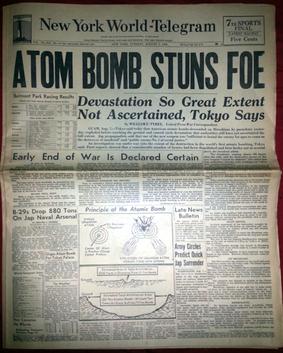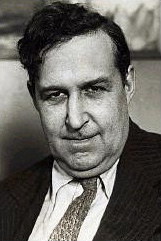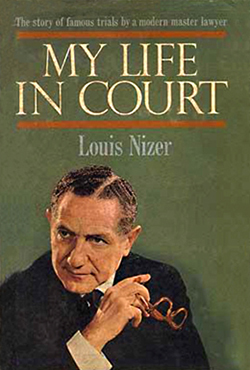
The New York World-Telegram, later known as the New York World-Telegram and The Sun, was a New York City newspaper from 1931 to 1966.

Francis James Westbrook Pegler was a populist conservative journalist and writer in the United States described as "one of the godfathers of right-wing populism". He was a newspaper columnist popular in the 1930s and 1940s for his opposition to the New Deal, labor unions, and anti-lynching legislation.
Gertz v. Robert Welch, Inc., 418 U.S. 323 (1974), was a landmark decision of the US Supreme Court establishing the standard of First Amendment protection against defamation claims brought by private individuals. The Court held that, so long as they do not impose liability without fault, states are free to establish their own standards of liability for defamatory statements made about private individuals. However, the Court also ruled that if the state standard is lower than actual malice, the standard applying to public figures, then only actual damages may be awarded.
Joint Anti-Fascist Refugee Committee v. McGrath, 341 U.S. 123 (1951), was a United States Supreme Court case that held that groups could sue to challenge their inclusion on the Attorney General's List of Subversive Organizations. The decision was fractured on its reasoning, with each of the Justices in the majority writing separate opinions.

Heywood Campbell Broun Jr. was an American journalist. He worked as a sportswriter, newspaper columnist, and editor in New York City. He founded the American Newspaper Guild, later known as The Newspaper Guild and now as The NewsGuild-CWA. Born in Brooklyn, New York, he is best remembered for his writing on social issues and his championing of the underdog. He believed that journalists could help right wrongs, especially social ills.
In US law, false light is a tort concerning privacy that is similar to the tort of defamation. The privacy laws in the United States include a non-public person's right to protection from publicity that creates an untrue or misleading impression about them. That right is balanced against the First Amendment right of free speech.

Quentin James Reynolds was an American journalist and World War II war correspondent. He also played American football for one season in the National Football League (NFL) with the Brooklyn Lions.
Dennis Jacobs is a senior United States circuit judge of the United States Court of Appeals for the Second Circuit.
Reginald Douglas Collins was a British-born Canadian journalist. He was also a Holocaust denier who was frequently accused of racism and anti-Semitism.
Louis Nizer was an American trial lawyer based in New York City. He was the senior partner of the law firm Phillips, Nizer, Benjamin, Krim & Ballon. In addition to his legal work, Louis Nizer was an author, artist, lecturer, and advisor.

Funding Evil: How Terrorism is Financed and How to Stop It is a book written by counterterrorism researcher Dr. Rachel Ehrenfeld, director of the American Center for Democracy and the Economic Warfare Institute. It was published by Bonus Books of Los Angeles, California in August 2003.
Modern libel and slander laws in many countries are originally descended from English defamation law. The history of defamation law in England is somewhat obscure; civil actions for damages seem to have been relatively frequent as far back as the Statute of Gloucester in the reign of Edward I (1272–1307). The law of libel emerged during the reign of James I (1603–1625) under Attorney General Edward Coke who started a series of libel prosecutions. Scholars frequently attribute strict English defamation law to James I's outlawing of duelling. From that time, both the criminal and civil remedies have been found in full operation.
Conversion is an intentional tort consisting of "taking with the intent of exercising over the chattel an ownership inconsistent with the real owner's right of possession". In England and Wales, it is a tort of strict liability. Its equivalents in criminal law include larceny or theft and criminal conversion. In those jurisdictions that recognise it, criminal conversion is a lesser crime than theft/larceny.

United States Naval Institute v. Charter Communications, Inc., is a notable contract case for discussing the extent and purpose of awarding damages in a breach of contract.
Time, Inc. v. Hill, 385 U.S. 374 (1967), is a United States Supreme Court case involving issues of privacy in balance with the First Amendment to the United States Constitution and principles of freedom of speech. The Court held 6–3 that the latter requires that merely negligent intrusions into the former by the media not be civilly actionable. It expanded that principle from its landmark defamation holding in New York Times v. Sullivan.
Dean Witter Reynolds Inc. v. Byrd, 470 U.S. 213 (1985), is a United States Supreme Court case concerning arbitration. It arose from an interlocutory appeal of a lower court's denial of brokerage firm Dean Witter Reynolds' motion to compel arbitration of the claims under state law made against it by an aggrieved former client. The Court held unanimously that the Federal Arbitration Act required that those claims be heard that way when the parties were contractually obligated to do so, even where parallel claims made under federal law would still be heard in federal court.

Obsidian Finance Group, LLC v. Cox is a 2011 case from the United States District Court for the District of Oregon concerning online defamation. Plaintiffs Obsidian Finance Group and its co-founder Kevin Padrick sued Crystal Cox for maintaining several blogs that accused Obsidian and Padrick of corrupt and fraudulent conduct. The court dismissed most of Cox's blog posts as opinion, but found one single post to be more factual in its assertions and therefore defamatory. For that post, the court awarded the plaintiffs $2.5 million in damages. This case is notable for the court's ruling that Cox, as an internet blogger, was not a journalist and was thus not protected by Oregon's media shield laws, although the court later clarified that its ruling did not categorically exclude blogs from being considered media and indicated that its decision was based in part upon Cox offering to remove negative posts for a $2,500 fee. In January 2014 the Ninth Circuit Court affirmed in part and reversed in part the district court's judgment awarding compensatory damages to the bankruptcy trustee. It also ordered a new trial on the blog post at issue.
Harte-Hanks Communications Inc. v. Connaughton, 491 U.S. 657 (1989), was a case in which the Supreme Court of the United States supplied an additional journalistic behavior that constitutes actual malice as first discussed in New York Times Co. v. Sullivan (1964). In the case, the Court held that departure from responsible reporting and unreasonable reporting conduct alone were not sufficient to award a public figure damages in a libel case. However, the Court also ruled that if reporters wrote with reckless disregard for the truth, which included ignoring obvious sources for their report, plaintiffs could be awarded compensatory damages on the grounds of actual malice.

My Life in Court is a 1961 memoir by American trial lawyer Louis Nizer documenting his career in law. The work was a best seller when it was first released, lasting for 72 weeks on The New York Times Bestsellers list.

Bent Coppers: The Inside Story of Scotland Yard's Battle Against Police Corruption is a non-fiction book by award-winning British journalist Graeme McLagan. First published in the United Kingdom in 2003 by Orion Publishing Group, the book examines police corruption within the Metropolitan Police Service and South Eastern Regional Crime Squad—with particular focus on the 1990s and early 2000s—and the establishment and activities of the force's anti-corruption "Ghost Squad". Its publication led to a 4-year legal case resulting in a landmark ruling in English defamation law.









